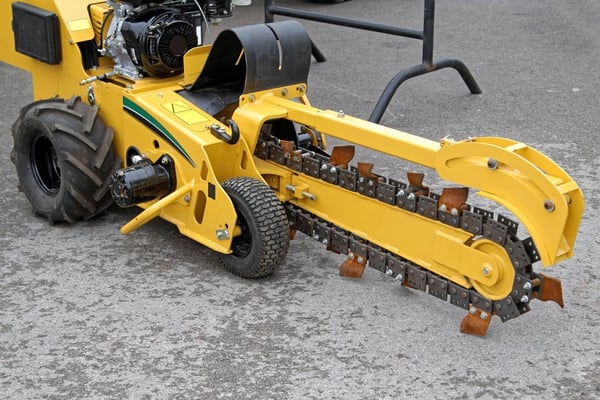A trench digger can come in handy for various jobs around the house or on a construction site. Below, we describe what a trench digger is and some of the most popular ways a trench digger for hire can be used.
Find a trencher for your next job
What is a trench digger?
A trench digger can be used instead of manually digging a trench with a shovel. Digging a trench manually can take a long time and require many people. Comparatively, one person can use a trencher machine and finish a project within a few hours. Trencher machines feature a metal chain with teeth used to cut into the soil, trenchers come in multiple sizes and can dig a trench at a wide variety of depths and widths.
Different types of trenchers
Large trenching machines such as the Ditch Witch Trencher HT275 can cut trenches up to ten feet deep and twenty-six inches wide. The Ditch Witch Trencher has improved operator visibility and is handy in areas with tough soil or where the ground can be covered in inches of frost and snow. The Ditch Witch ride-on trenchers provide high-performance trenching for large projects.
Smaller trenching machines such as the Vermeer trencher pedestrian models are best for small-depth trenches, such as trenches that are three to four feet deep. Vermeer trenchers are handy when there is limited access to the job site and when there needs to be minimal damage to the surrounding area. The Vermeer walk-behind models are perfect for restricted access trenching.
What can I use a trencher for?
1. Removing tree roots
Ensure you have a trencher blade appropriate for cutting through roots and other underground obstacles, such as a trencher chain with carbide teeth. Without one of these blades you could damage the trencher machine and may even break teeth off the chain or break the chain altogether. Firstly, dig the soil out from around the root, so you can clearly see the root and position the blade easily. Slowly start the trencher machine and hold the trencher machine in place while the blade spins. Walk forward gradually and inch the trencher blade into the root, allowing the blade to cut through the roots. The cut roots can now be easily removed from the soil.

2. Cutting through pavement and concrete
A trencher machine can cut through pavement, concrete, or asphalt surface. To do this you’ll need a trench-cutting floor saw or a road saw trencher. A trencher road saw has two parallel blades so it can effectively cut through the surface. The floor saw has only one blade, so it will take longer and the blade will wear down faster but you can still get the job done. A trench cutting road saw is preferable if you need to get the job done quickly.
3. Flood prevention
Badly designed drainage or a lack of drainage altogether allows water to soak into the soil, causing boggy spots, potentially leading to flooding. If you have a trench in place you can prevent water from causing damage to landscaping and structural foundations. After using a portable trencher to dig up the soil, various irrigation systems can be used underground to allow water to drain off.
4. Burying electrical wires
Power companies often use trench diggers to save time, so more time can be spent ensuring the placement and security of the electrical wires. The depth of the trench will be determined by the wiring method needed. When digging with a trench digger ensure there are no gas lines, electrical wires, water pipes, or sewer lines in the direct line of digging.
5. Garden remodeling
Instead of bending your back and digging up the backyard, use a small trenching machine to save hours of work. Small trenching machines are perfect for garden work and landscaping. When operating a trench digger ensure you are wearing appropriate clothing, including: closed in shoes, long-sleeved shirt, hard hat and protective glasses. After hiring your trench digger machine, first make sure you know how to use the trenchers key operating functions.


